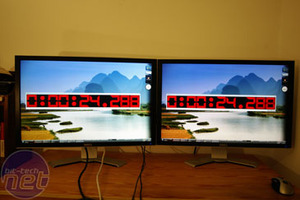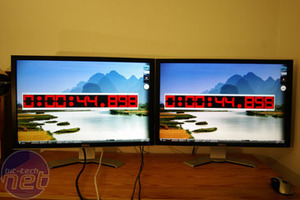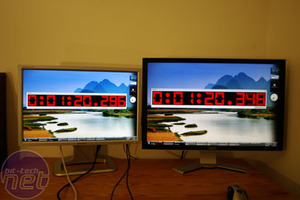
Capturing Input Lag
Despite the lack of co-operation from Dell and Samsung, getting a rough relative measure of input lag is actually very easy.All you need is a PC with a dual output graphics card, a screen you suspect of lagging, a second display with little or no lag, a decent digital camera and a stopwatch application (alternatively, you can use the embedded input lag stopwatch in Lagom). Simply configure the two monitors in clone mode, fire up the stopwatch app and begin taking pictures.
What you’re looking for is a discrepancy in the time displayed on the two screens. If both displays have no lag (or the same amount of lag) then the time displayed on the stopwatch application at any given moment will be identical.
However, if one display lags the other, the elapsed time it displays will be lower. Any difference should be obvious from the captured images.
Samsung’s 244T is a prime suspect for input lag, so was an obvious candidate for testing. For comparison, our control display was Dell’s 30in 3007WFP. Crucially, this TFT has absolutely no image processing circuitry to slow things down. It simply displays the pure digital signal with which it is fed.
Getting a really precise handle on the Samsung 244T’s lag is tricky. The stopwatch app may be capable of measuring thousandths of a second, but LCD response times aren’t quite quick enough to allow each successive thousandths digit to be displayed clearly. What's more, even if the individual pixels could change state fast enough, you have to account for the fact that the monitor as a whole only refreshes at 60Hz. To accurately display a clock that runs to thousandths of a second, a refresh rate in the kilohertz would be required.


Two identical Dell monitors show that there's no difference in lag between the two DVI ports - click to enlarge
Still, we found the Samsung 244T’s lag was bad enough to be obvious despite those constraints. As our images demonstrate, the Samsung 244T lags by approximately 40 to 60ms compared to the Dell 3007WFP. At this point that we should point out that these results are completely consistent regardless of the brand or GPU of graphics card we used. Likewise, swapping the monitors round on the DVI ports had no impact on the results. Just to emphasise this, we’ve included shots of a pair of identical Dell monitors in clone mode displaying almost exactly the same time on the stopwatch application.

MSI MPG Velox 100R Chassis Review
October 14 2021 | 15:04










Want to comment? Please log in.